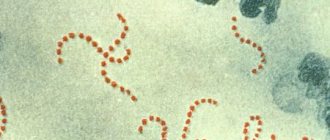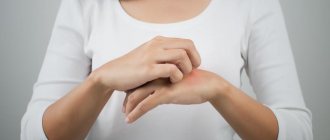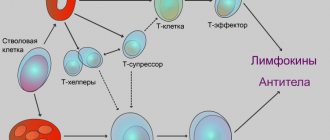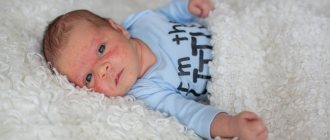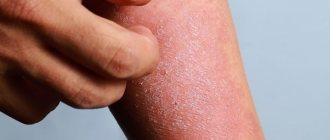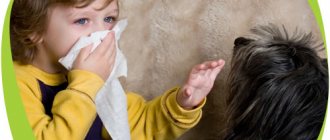Atopic dermatitis in children is a chronic, recurrent inflammatory skin disease with an immune mechanism. As a result of hypersensitivity reactions to various antigens (food products, pneumoallergens, bacterial proteins), a number of inflammatory factors are released in genetically predisposed children.
This results in eczematous lesions, which consist of edema and microvesicles, leading to itching, irritation, scratching and inflammatory lesions, symmetrical, varying in appearance and location depending on the age of the child. It is often associated with asthma, rhinitis and food allergies.
Types of atopic dermatitis
Experts identify the following types of disease:
- Infant (from birth to 2 years). The first signs appear in the first months of life. The rash is localized in the cheeks and forehead. This type of disease is popularly called diathesis. Affected areas become wet and swollen
- Children (from 2 to 12 years old). It worsens when the skin comes into contact with an irritant. It is characterized by excessive dryness and itching.
Depending on the pathogen, there are the following clinical and etiological options: food, fungal, tick-borne and pollen. A type of disease with secondary infection is also distinguished.
Reasons for development
Childhood atopic dermatitis is a public health problem in developed countries and has a prevalence of 10 to 20%. Within the same country, rates are higher in urban areas and among populations with higher standards of living. With age, the prevalence and intensity of the disease decrease. 60% of patients are diagnosed in the first year of life, mainly in the first six months, in 85% in the first 5 years and only in 10% after 7 years.
In 70-80% of patients it develops against the background of a hereditary predisposition. The genetic basis is combined with various immunological changes in the skin, which cause dysfunction of the protective barrier:
- mutations lead to the appearance of microcracks, transepidermal loss of moisture and pH imbalance;
- this facilitates the entry of environmental irritants, allergens (mites, food, pollen) that increase sensitivity, and pathogens such as Staphylococcus aureus.
These factors lead to cellular infiltration of the dermis and constant inflammation with an initial imbalance of lymphocytes that produce Ig E upon contact with allergens. Subclinical inflammation persists even beyond exacerbation
Main causes of the disease:
- Excessive dryness. Patients have a defect that prevents the skin from moisturizing. The situation is especially worse in winter due to the use of heaters and reduced indoor humidity. Frequent washing without subsequent moisturizing also dries.
- Stimulus. Various household chemicals and low-quality care products can cause burning, redness, itching or dryness.
- Emotional stress. Sheer disappointment, fear and anger are provocateurs to which the child’s skin reacts with itching and redness.
- Excessive sweating. If clothing is not appropriate for the weather, the skin performs the function of thermoregulation - it sweats, which leads to a worsening of the clinical picture.
Separately, infection with staphylococcus should be considered. In this case, outlined areas or vesicles with pus appear. The disease can be caused by herpes and fungus. In rare cases, pollen, dust mites and pets cause atopic dermatitis in very young children.
How to prevent and treat recurrent inflammation in AD?
Treatment of AD is complex and requires constant monitoring of skin condition. This is especially important for children, who most often cannot determine which foods they are allergic to and in what situations. Patients must minimize exposure to allergens, which is not easy due to the multiplicity of allergens and their prevalence.
Symptoms of atopic dermatitis increase in response to stress, so to prevent relapses, it is recommended to avoid stressful situations, especially when it is chronic.
During an exacerbation of symptoms, it is necessary to consult a dermatologist who will select appropriate antihistamines, which also have antipruritic properties, and other drugs that inhibit the development of allergies - for topical or general use (for example, immunosuppressants).
Treatment of recurrent inflammation in AD
It is worth taking care to exclude from the diet foods that make patients feel unwell and give a rash. Avoiding allergens in powders and mouthwashes that are highly irritating to already affected skin is also key.
Avoid clothing made from wool and other “caustic” materials. The quality of the bed linen on which the patient sleeps is important. It should also be soft and non-irritating. Hygienic and cosmetic procedures also affect the condition of the skin in AD. Avoid exfoliating cleansers and soaps and moisturize and lightly lubricate your skin regularly.
Symptoms of atopic dermatitis in children
Clinical manifestations form the basis of diagnosis, as there are no specific microscopic or laboratory changes.
Main manifestations depending on age:
- Babies. Signs of the disease appear from the second month, with erythematous exanthema, with a large exudative component that forms scabs and is localized on the cheeks, forehead, and also affects the nasolabial triangle. Distributes symmetrically to the scalp, front part of the body and limbs. The diaper area is usually left untouched.
- Children from 2 to 12 years old. Skin manifestations may begin at this stage or recur after a free interval of up to 2-3 years. Localization is typical on the elbow bends and popliteal folds. There is a characteristic itching in the affected area. Other typical sites include the thighs, wrists, eyelids, hands and fingers.
- Teenagers. Papular and lichen-like lesions predominate in this phase based on intense xerosis. It is predominantly localized in large folds, on the upper third of the arms and back, the back of the arms and legs, and on the fingers.
Symptoms that should alert parents: dry skin, small cracks in the crease of the earlobe, fingers and toes, redness and peeling on the back of the toes or mouth. Hyperkeratosis, which gives the appearance of goosebumps, is localized on the buttocks, deltoid region, outer thighs and torso. Erythematous plaques on the cheeks, dark circles under the eyes and pallor may occur.
Possible complications
Complications of atopic dermatitis in children:
- Asthma and allergic rhinitis (hay fever). Sometimes eczema precedes these diseases. More than half of young children with atopic dermatitis develop asthma and allergic rhinitis by age 13.
- Chronic itching and flaking. This disorder can cause the affected area to change color and become thicker.
- Skin infections. Infection increases the risk of contracting bacteria and viruses, such as the herpes simplex virus.
- Allergic contact dermatitis. This disease often occurs in patients with atopic dermatitis.
- Sleep problems. The characteristic severe itching can lead to insomnia.
Diagnosis of atopic dermatitis
A test for general and specific Ig E is prescribed to determine the cause of skin inflammation. The doctor makes the diagnosis by examining the affected areas and taking a medical history. The specialist may also use patch tests or other tests to rule out other skin conditions.
If parents suspect that a certain food was the cause of a rash on the child’s body, then they need to inform the doctor about this and ask about the possibility of identifying potential food allergens. In this case, a diet is prescribed for treatment.
Main goals and directions of therapy
AD is a chronic disease, so treatment should be gradual and long-term.
- Elimination of causally significant allergens with the prescription of diet therapy and control of adverse environmental factors;
- Elimination or reduction of inflammatory changes on the skin and skin itching.
- Restoring the structure and function of the skin (improving microcirculation and metabolism in lesions; normalizing skin moisture).
- Prevention of the development of severe forms of the disease, leading to a decrease in the quality of life of patients and their disability.
- AD is based on allergic inflammation, so the basis of treatment is antihistamines and anti-inflammatory drugs.
- Multiple organ lesions in AD require systemic basic therapy with antiallergic drugs.
- Identification and treatment of concomitant diseases that aggravate the course of AD. (treatment of pathologies of the digestive system, metabolite and antioxidant therapy, normalization of functional disorders of the nervous system, rehabilitation of foci of chronic infection).
Areas of AD therapy:
- diet therapy and elimination measures to eliminate causally significant allergens;
- systemic pharmacotherapy;
- antihistamines;
- membrane stabilizing drugs;
- drugs that normalize the functions of the digestive system;
- vitamins;
- immunomodulators;
- drugs that regulate the function of the ANS;
- preparations containing unsaturated fatty acids;
- antibiotics;
- systemic corticosteroids (for special indications);
- External therapy and rehabilitation.
Correction of immune disorders in AD
- Direct methods of immunocorrection are allergen-specific immunotherapy (ASIT), therapeutic plasmapheresis, and immunopharmacotherapy itself with corrective drugs, as well as the use of modern immunosuppressants.
- ASIT is the only method of therapeutic influence on all pathogenetically significant parts of the allergic process, which has a long-term preventive effect and allows for the reverse development of the pathological process, because at the same time, a decrease in nonspecific tissue sensitivity to the allergen is formed, hyperreactivity decreases, and signs of allergic inflammation are suppressed, which indicates a restructuring of the nature of the cellular and cytokine response from Th2 to Th1 - a response with a decrease in the content and production of Ig E.
Indications for ASIT are determined by a set of criteria:
- diffuse or widespread form of AD;
- moderate/severe;
- clinically significant sensitization to aeroallergens, confirmed on the basis of anamnesis, positive skin tests and/or detection of specific Ig E antibodies to a given allergen;
- hereditary burden of allergic diseases, especially respiratory allergies;
- hypersensitivity to one group of allergens.
Treatment of atopic dermatitis in children
Atopic dermatitis can be permanent. You may need to try multiple treatments over several months or years to control the disease. Even if treatment is successful, signs and symptoms may reappear.
Early detection of the disease allows timely treatment to begin. That is why, when primary symptoms appear, you need to contact an allergist-immunologist or dermatologist.
If regular moisturizing and other personal hygiene measures do not help, your doctor may suggest medication:
- Corticosteroid ointments. Relieve itching and help restore skin. Apply them according to the instructions after moisturizing the skin to avoid adverse reactions.
- Calcineurin inhibitors. Ointments are prescribed for ages 2 years and older. Affect the immune system. Avoid intense sunlight when using these products.
- Medicines to fight infection. Antibacterial cream is prescribed for bacterial infections, open sores or cracks. Oral antibacterial drugs may also be prescribed.
- Medicines to control inflammation. In severe cases, your doctor may prescribe oral corticosteroids.
Effective and intensive treatment for severe forms of the disease involves wrapping the affected area with topical corticosteroids and moist dressings. The procedure is performed under the supervision of medical professionals.
Phototherapy (light therapy) is prescribed to children whose condition does not improve with local treatment. The procedure involves exposure to a controlled amount of natural sunlight alone or in combination with medications.
Although effective, long-term phototherapy has detrimental effects, such as premature aging and an increased risk of cancer. For these reasons, phototherapy is not often used in young children and is not performed in infants.
Allergic dermatitis in a child: causes
Option 1: Foreign irritant
An allergy is a nonspecific reaction of the body to a completely common irritant. When an allergy occurs, an irritant is usually understood as a foreign protein. The immune system identifies a foreign protein (antigen) and fights it through the formation of antibodies. Often another scenario “turns on” - some substances (they are called haptens) enter the blood, combine there with blood proteins and endow them with “foreign” properties. Now our own, previously friendly blood proteins turn out to be “strangers” and become the target of the immune system. Special complexes that form an antigen with an antibody create the basis for the occurrence of allergic reactions.
Let’s explain this using a simple, “childish” example: imagine a protein in the form of a chain, like a train with several carriages. After this “composition” is eaten, the enzymes of the digestive system will begin to break down this protein - breaking the train down into trains and carriages. And if for some reason the two trailers remain together and do not separate, they will turn from normal “digested” protein into an allergen.
Result:
the liver, which produces “splitting” enzymes, is the most vulnerable (due to its immaturity) organ of a small child. Therefore, many “heavy” foods containing complex proteins (for example, chocolate) cannot be broken down by enzymes of the digestive system, thereby causing allergies. With age, the child’s liver will get stronger, and the baby, as they say, will “outgrow” the allergy without any medical intervention.
Option 2: Overload of the body
Considering the first option for the occurrence of an allergic reaction, everything seems very simple - you ate something “allergic”, this caused the production of antibodies in the body, as a result of which the skin became covered with a rash. And now the allergen, it would seem, has been “calculated, neutralized and excluded” and the disease has been successfully cured. But in practice, unfortunately, everything is not so rosy.
The child’s diet is changed many times, treatment is prescribed for the supposedly diseased intestines, everything that, at least theoretically, can cause an allergy is excluded - but there is still no result. A logical conclusion suggests itself - the cause of the disease does not lie in the quality of the food; there are other factors that provoke the occurrence of blood pressure.
And the essence of the problem is this: foreign irritants or poorly digested food residues constantly enter the child’s blood. Further, in the process of natural excretion, these substances leave the body in three ways:
- with urine;
- through the lungs;
- with sweat.
The skin reacts to these substances and a rash appears. That is, the “culprit” is indeed the digestive system, but is it the composition of the food? Any pediatrician will confirm: malnourished children are extremely rarely exposed to allergies, and when an intestinal infection occurs, which is accompanied by loss of appetite and diarrhea, skin manifestations in children with AD sharply decrease.
Result:
limiting the load on the intestines reduces the symptoms of allergic dermatitis. In other words, the child eats more than he can adequately digest, and all undigested excess accumulates in the intestines and turns into allergens.
Disease prevention
The following recommendations are aimed at preventing episodes of illness and minimizing the effects of dryness after bathing:
- Moisturize your skin at least twice a day. Use creams, ointments, or lotions that lock in moisture. Select one or more products suitable for your child.
- Try to identify and avoid triggers that make the condition worse. Prevent stress, negative effects of pollen dust. Dress your child according to the season to prevent him from sweating.
- Infants and children may experience flare-ups when consuming certain foods, such as eggs, milk, soy, and wheat. Talk to your doctor about how to identify possible food allergens.
- Use only mild soap. Choose products with a neutral pH level. Antibacterial soap removes natural oils and dries out the skin.
Water procedures should not exceed 10-15 minutes. After your bath, dry your skin gently with a soft towel and apply a moisturizer.
How to find the “golden mean” and prevent overeating?
So, we “treat” in order:
- regular bowel movements - Materna mixtures contain probiotics and prebiotics, which improve microflora and thereby contribute to the timely removal of undigested food debris from the body;
- if your baby is gaining weight well, and especially if he is ahead of the norm, do not “push up” already good digestion with additional enzymatic preparations, eubiotics, etc.;
- Do not forget that saliva is an “activator” of the digestion process. If you eat slowly, without haste, the benefits of saliva will increase. Make a smaller hole in the nipple, try to take the bottle away for a couple of minutes, maintain optimal heat and humidity parameters in the room to avoid dry mouth, walk in the fresh air more often;
- Materna formulas have a balanced protein composition characteristic of breast milk - albumin/casein 60/40. Formulas for children with intolerance to cow casein protein (Materna Soy) are also presented. You can switch your baby to this diet only after consulting a doctor. If the child is gaining more weight and suffers from blood pressure, but an allergy to cow's milk proteins has not been confirmed, you can temporarily try to reduce the concentration of the formula. The main thing here is not to overdo it; a reduction is allowed within half a measuring spoon of dry mixture per standard volume of water. Such a decrease in concentration will help relieve the liver and intestines, normalize digestion and get rid of the symptoms of blood pressure;
- if all of the above measures do not bring results, the child still suffers from rashes; most likely, the ratio of beneficial and opportunistic pathogenic microorganisms (dysbacteriosis) is disturbed in the digestive tract, which makes it impossible for the processes of absorption of beneficial and elimination of unnecessary substances to occur correctly. In this case, you need to consult a doctor and undergo the necessary tests.
Remember the main thing, do not under any circumstances overload the child’s intestines with excess food (do not exceed the amount of dry formula per feeding and the frequency of formula feedings per day). For a child suffering from allergic dermatitis, it is sometimes better not to feed additionally and to allow the body to remove all that is unnecessary, than to overfeed and load the digestive system with backbreaking work.
